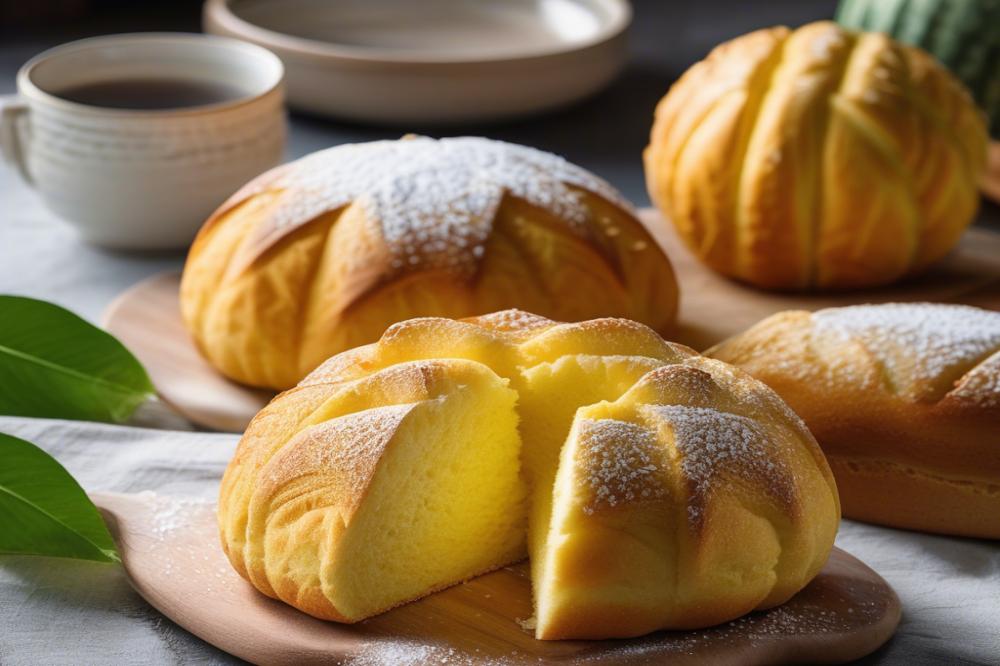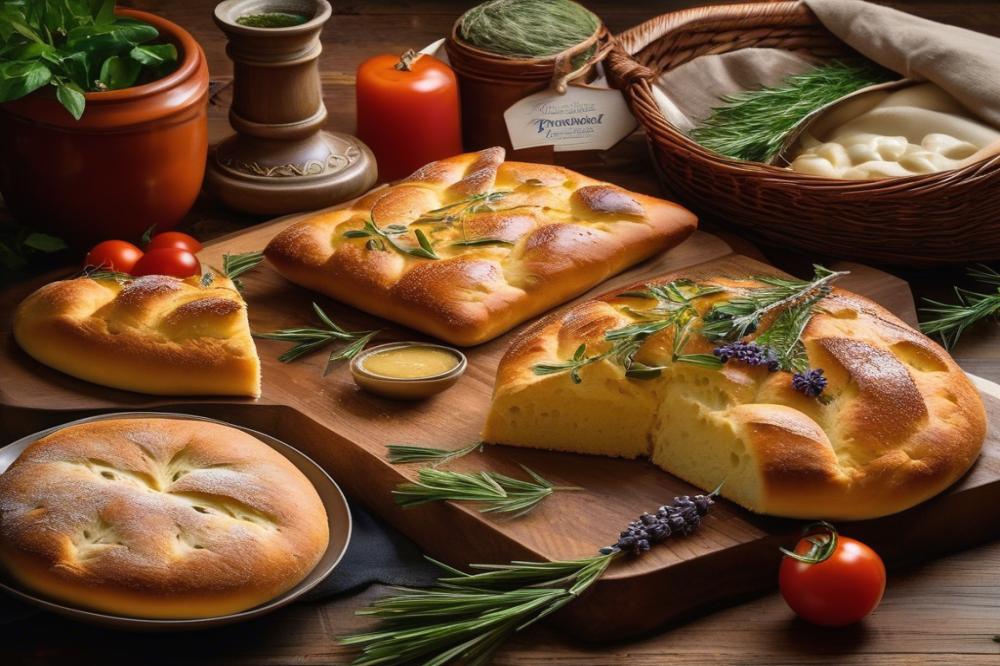Introduction
Melon Pan is a beloved type of sweet bread that has captured the hearts and taste buds of many. This delightful pastry features a crunchy crust that often resembles a melon’s surface. Despite its name, it does not actually contain any melon flavor. Instead, the name references its charming appearance and sweet taste. Inside, it boasts a soft interior that contrasts beautifully with the crunchy outer layer.
Often overlooked, this treat holds a special place in Japanese cuisine and culture. Its origins can be traced back to a fusion of bread-making techniques introduced by the West. Delicious and comforting, Melon Pan embodies the spirit of home-cooked meals and nostalgic memories. Furthermore, it serves as a dessert or snack that is enjoyed by people of all ages. Street vendors across Japan serve this delightful bread, bringing it to life in bustling markets and festivals.
Connections to street food traditions run deep, as many favorite recipes involve simple ingredients that anyone can recreate. Whether enjoyed warm out of the oven or simply grabbed on the go, this unique treat has found its place in everyday life. Melon Pan is not just a food; it’s a symbol of community and shared experiences, often evoking fond memories of childhood and family gatherings. Street food culture celebrates such treats, merging convenience with rich flavors, making it an essential part of the Japanese culinary landscape.
What is Melon Pan?

Melon Pan is a delightful type of pastry popular in Japanese cuisine. This sweet bread has a distinct appearance. It features a golden-brown, crunchy crust on top, which gives it an eye-catching look. The soft interior contrasts with the crust, creating a pleasing texture with each bite. People often enjoy it as a dessert or a snack while on the go.
The sweet bread and the crunchy crust are what make this treat truly special. While the outer layer is crisp, the inside remains fluffy and tender. This combination creates a satisfying experience for those who take a bite. Many liken the feel of the crust to the texture of a cookie, offering a delightful surprise when biting into the bread.
Interestingly, despite its name, Melon Pan does not usually carry a strong melon flavor. The name originates from the bread’s resemblance to a melon’s appearance, particularly a cantaloupe. Some recipes incorporate a hint of melon extract, but that’s not always the case. It is more about the visual impression rather than an actual fruity taste. Often, people love this delightful pastry for its sweetness and charm rather than its supposed flavor.
You can find Melon Pan in various formats across street vendors and bakeries. This bread has become a favorite for many who appreciate its unique look and texture. Chefs enjoy experimenting with different recipes, making variations that incorporate other flavors. Ultimately, everyone can find something appealing about this lovely bread.
Ingredients Needed for Melon Pan

Making this delicious sweet bread involves several essential ingredients that come together to create a delightful treat. Here’s a list of what you’ll need.
Essential Ingredients
- 2 cups of all-purpose flour
- 1/2 cup of sugar
- 1/2 cup of warm milk
- 1/4 cup of unsalted butter, softened
- 1 large egg
- 1 packet of instant yeast (about 2 1/4 teaspoons)
- 1/2 teaspoon of salt
For the topping, you will also need:
- 1 cup of cake flour
- 1/2 cup of sugar
- 1/2 cup of unsalted butter, softened
- 1 large egg
- 2 teaspoons of baking powder
- 1 tablespoon of melon flavoring or extract
Suggestions for Variations
There are many ways to twist these recipes to suit your tastes. Consider adding fillings like sweet red bean paste or custard for a change from the traditional style. Alternatively, try experimenting with flavors like matcha or chocolate to bring some variety to the crunchy crust.
Fresh fruit pieces could also be added right into the dough. This adds moisture and a nice surprise with each bite. While melon flavoring is classic, vanilla or even lemon can provide a zesty twist.
For a more colorful touch, you can sprinkle edible glitter on top of the pastry before baking. This makes it visually appealing, perfect for street food events or dessert gatherings. The options are nearly endless, allowing you to personalize your melon pan experience.
Method for Baking Melon Pan

Step-by-step Instructions for Making the Dough
Start by gathering your ingredients. You’ll need all-purpose flour, sugar, yeast, salt, whole milk, and eggs. Begin by warming the milk until it is slightly warm to the touch. Mix the sugar and yeast into the warm milk, allowing it to sit for about 5 to 10 minutes. This helps the yeast activate, creating a bubbly mixture.
Add the yeast mixture to a bowl with flour, salt, and eggs. Stir until everything forms a rough dough. Next, knead this dough on a floured surface for about 10 minutes. Aim for a smooth, elastic texture. Place the kneaded dough into a greased bowl, cover it with a cloth, and let it rise for about an hour. A warm environment will help the dough expand.
Preparation of the Crunchy Topping
While the dough is rising, focus on the crunchy crust. Combine softened butter, sugar, flour, and an egg to create the topping. You’re looking for a texture similar to cookie dough. To enhance the melon flavor, add a few drops of melon essence or extract if available. After mixing, cover this topping with plastic wrap and refrigerate it for later use. Chilling the mixture helps it hold its shape when placed on the dough.
Combining the Components and Baking Process
After the dough has doubled in size, punch it down to eliminate excess air. Divide the dough into equal portions—about six or eight, depending on your desired size. Shape each piece into a round ball and let them rest for about 15 minutes.
Now it’s time to shape the topping. Take the chilled mixture and form it into flat discs. Gently place a disc on top of each dough ball. Use a knife to create a crisscross pattern on the topping, which is the signature look of this delightful dessert. Preheat your oven to 350°F (175°C), then let the dough rest again for about 30 minutes before baking.
Once they are ready, bake the balls for about 15-20 minutes. The result should be a delightful sweet bread with a golden-brown crunchy crust that contrasts beautifully with the soft interior.
Tips for Achieving the Best Texture
To obtain the best results, consider a few tips. Always check the yeast’s freshness before starting. Activating it properly is crucial for fluffy bread. When kneading the dough, don’t rush the process. The more you knead, the better the texture will become.
Room temperature ingredients can make a difference, so ensure your butter and eggs are at the right temperature before mixing. Lastly, baking time can vary. Keep an eye on your pastries as they bake to avoid over-browning. Enjoy these sweet creations as a delightful street food or dessert straight from Japanese cuisine.
Serving and Enjoying Melon Pan
Traditional Ways to Serve Melon Pan
Often enjoyed fresh from the bakery, this sweet bread is a delight on its own. Many people like to eat it warm, savoring the contrast between the crunchy crust and the soft interior. Some choose to slice it open and spread a bit of butter inside for added richness. It is common to serve melon bread during casual gatherings, making it a favorite snack in both homes and cafes.
Pairing Suggestions
A variety of drinks complement this pastry beautifully. Green tea or jasmine tea can enhance the flavors, offering a mild contrast. For those seeking something different, coffee is a popular choice, balancing sweet notes with a robust flavor. When it comes to dessert, consider pairing it with fruit or yogurt. Ice cream also makes a fantastic match, adding a creamy aspect to the overall experience.
Popular Locations in Japan to Buy Melon Pan
In Japan, numerous bakeries specialize in these baked goods. Local convenience stores often carry them as well, making access easy. Specific shops, like Pan no Matsuya in Tokyo, are renowned for their delicious versions that attract long lines. Street vendors also sell various styles, often with exciting toppings or fillings. Visiting these places gives a taste of how this dish fits into everyday life in Japanese culture.
Variations of Melon Pan
Overview of Different Regional Styles
Melon Pan shows off a variety of styles across Japan. In Tokyo, it’s typical to see the classic version. Bakers focus on a light sweetness with a crunchy crust. Hokkaido, however, offers a richer and creamier twist. Here, the sweet bread often includes more dairy. Each region adds local flair, creating surprises for anyone trying them.
Creative Twists on the Classic Recipe
Modern bakers have started experimenting with this traditional pastry. One popular variation includes adding chocolate chips for a rich sweetness. Another creative twist mixes in matcha, giving it a vibrant green hue. Some even make savory versions, using cheese in the soft interior instead of a classic filling. These innovations breathe new life into the beloved dessert, making it even more appealing.
Incorporating Seasonal Ingredients
Seasonal ingredients also inspire unique recipes. In spring, cherry blossom petals might be added for a floral hint. Summer can bring refreshing citrus, like yuzu or lemon, brightening the flavor palette. Autumn often sees pumpkin puree mixed into the dough, creating a cozy treat. Winter recipes may incorporate festive spices, like cinnamon, to warm the heart. This flexibility allows Melon Pan to stay relevant throughout the year and appeals to various tastes.
Wrapping Up the Joy of Melon Pan
This delightful sweet bread has a charm that captures hearts and taste buds alike. Its soft texture, combined with a crispy cookie crust, creates a wonderful experience for anyone who takes a bite. The blend of flavors and that beautiful golden-brown exterior makes it hard to resist. Many people find it comforting and nostalgic, often reminding them of warm memories from their childhood or special moments spent with loved ones.
Making this pastry at home can be a rewarding adventure. You might discover the joy of baking as you experiment with different flavors or techniques. Trying out your own version is not only fun, but it may also give you a chance to impress family and friends. With just a few ingredients and some patience, you can create something truly special in your kitchen.
Lastly, Asian-style baking opens up a world of delicious possibilities. Each creation, whether it be fluffy buns or crispy pastries, can bring smiles and satisfaction. Embrace the process of learning how to bake these delightful treats. You never know, the joy you find in making melon bread could spark a new passion for you. So, roll up your sleeves and dive into this enjoyable culinary adventure!



